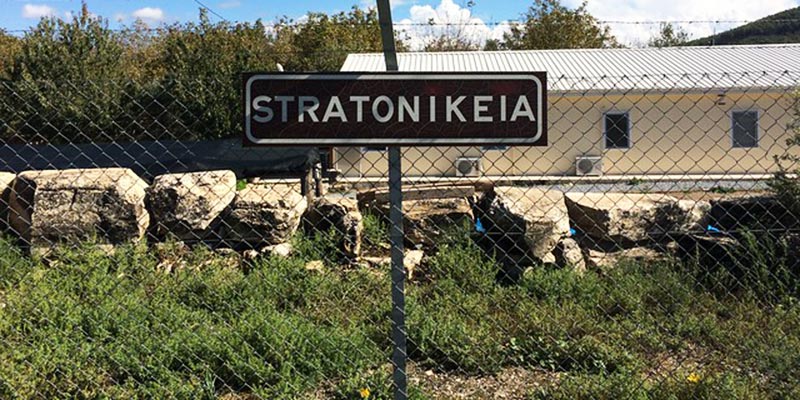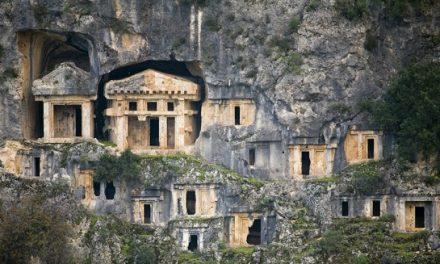History of Stratonikeia
Stratonikeia is located within the borders of Eskihisar District, 7 km west of Yatağan District of Muğla Province. The ancient city is on the side of the new Yatağan-Milas highway.
In the first quarter of the 3rd century BC, Seleucid king Antiochus I, the founder of the city, which is said to have been born from a love legend and located on a great religious road, had this place built first for his stepmother and then for his wife Stratonike. In Stratonikeia, named after his wife Stratonike and known as the city of immortal loves and gladiators, there was an uninterrupted settlement from the late Bronze Age to the present day.
According to the ancient geographer navigator Strabon, Stratonikeia was equipped with very beautiful structures. It is understood that the coins of Stratonikeia, which were found in the excavations, started to be minted from 167 BC when the city gained its independence from Rhodes and continued until the time of Gallienus (253-268).
Ancient Stratonikeia, which changed hands between Seleukos, Ptolemaios, Macedonians, Rhodes and Rome in the Hellenistic Period, BC. In 130 BC it was completely attached to Rome. In the city, which came under Turkish rule after the conquest of Anatolia, settlement continued in the principalities, Ottoman and Republican periods. In Eskihisar Village, which moved to a new settlement area after the earthquake in 1957, there are still a few families living in historical village houses.

Stratonikeia-Photo by lithics50 on Flickr
The Story of Stratonikeia
Young and famous for her beauty, Stratonike was chosen as a wife by the king of the time. The young and handsome son of the king falls in love with his father’s new wife. He falls into bed from his love. No doctor can find a cure. His father is very upset about his son’s condition. At that time, the physician Erasistratos from a Kos Island in the country was summoned to the palace, and he was asked to see the patient as well. The doctor tries for days, but cannot find a cure for the disease.
One day, Stratonike enters the patient’s room, and at that moment the king’s son blushes and his heart begins to beat faster. Of course, this does not go unnoticed by the doctor. As soon as the girl leaves the room, she pinches the boy and learns about their love for each other. Now, as he thinks about how to tell this to the king, an idea comes to his mind.
He tells the king that his son fell in love with the doctor’s wife and fell into bed because of his love. The king asks the doctor to give up his wife for his son. The doctor asks how he would act if he were in the same situation. The king says he will give up on his wife without thinking.
The doctor got the answer he wanted. He tells the truth to the king… The king allows his son and Stratonike to marry, and leaves the throne to his son. The king is Nikator I, the king of the Seleucids, and his son is Antiochus. Antiochus establishes Stratonikeia for Stratonike, who first became his stepmother and then his wife. Describing this event, Stephanos of Byzantion says that the city was founded between 281-261 BC.
According to a rumor…
Once upon a time, there was a Syrian king named Seleukos I, the owner of fertile plains and powerful armies. Like a lion, he had a son named Antiochus. Everything was fine, it was nice, but Seleukos felt the absence of a woman who would make him forget his wife, who he lost years ago, and at least alleviate his sadness… Until he met Stratonike… A magnificent wedding was held without even waiting for Antiochus in the distant provinces to return… Come see that the joy of Seleukos is not much, it only lasted until the son and stepmother met. The meeting of these two people, who will be attracted to each other at first sight, seems inevitable, but why now, why here? Seleukos’ heart is burning and his mind is being gnawed with these questions.
Convinced that giving up neither his wife nor his son will bring peace, the ascetic king thinks carefully, weaves tightly, and finds the solution to remove Antiochus and Stratonike from their lands. He advises them to go far away and establish their own cities, orders them not to return again, and gives whatever is necessary, the convoy sets off…
Here Stratonikeia is the city that Antiochus founded in the name of his old stepmother and his new wife Stratonike, in the far southwest of Anatolia.
It is said that Seleukos behaved like a mature king, spared Antiochus and Stratonike, and gave them the power to establish their own cities… But it is also said that he cursed them with his unceasing anger, “Let their cities fall on their heads eight times, so that they may not see peace…”
I don’t know how many times before, but the city of Stratonikeia has changed places 3 times since its name was Eskihisar.

Stratonikeia- Photo by Lis-Broon on Flickr
City Structure of Stratonikeia
The city was surrounded by walls and today only minor extensions of the city walls are visible. In the northeast corner of the settlement are the ruins of a mighty castle built of large cut stones and lime mortar. It is understood from the inscribed stones and column bodies taken from other buildings that the building, which was built of large cut stones and lime mortar, was repaired.
The main entrance gate on the northern side of the city consists of large blocks woven with wide and thin stone masonry. There is a nymphaion between the two door entrances of the structure with two arched entrances. After the door, the presence of a columned area and a road can be seen.
While the city’s acropolis is located on the top of the mountain in the south, the remains of a small temple built for the emperor stand out in an inscription on a terrace on the hillside, just below the current highway.
Stratonikeia is one of the rare places where the structure and urban texture of the Archaic, Classical, Hellenistic, Roman Empire, Byzantine, Principalities, Ottoman and Turkish Republic periods can be seen together. Stratonikeia, which is one of the largest cities in the world built of marble with an area of 7 km, was arranged in a Hippodamic plan consisting of intersecting streets in a parallel grid system during the Hellenistic Period.
In the middle of the city, the most striking structure of the city, the bouleuterion, where the city council meets, is located. The bouleuterion, a small theater-like structure, is the gate that stands alone just to the west of this building. On the north-facing outer wall of the Bouleuterion are inscriptions in Latin, the introductory part of Diocletian’s price list and its implementation. The lower benches of this building have been preserved. To the west of the city, there is a building called gymnasion, where young people in Ancient Greece and Rome were educated intellectually and physically, where they were educated and participated in sports activities.
There are chamber tombs on the side of the sacred road in front of the entrance to the city. The sacred road starting from the entrance gate passes through the necropolis and reaches the Hecate sanctuary in Lagina. The necropolis area in question has been destroyed by being under the coal mines basin today. There is also Mysia Stratonikeia.
Within the Ancient City of Stratonikeia, two different fortification walls with a length of 3,600 m from the Archaic and Classical Periods, the largest gymnasium and theater of Anatolia from the Hellenistic Period, the Parliament Building (bouleuterion) dating to the Roman Imperial period, bath complexes, agoras, temples, city gates, There are structures such as a columned street, fountains and water structures, and grave monuments. Apart from the calendar inscription of Menippos in Greek (August period) on the walls of the Bouleuterion (Assembly Building), there are names and prices of all goods and services sold in the city during the Roman Period (AD 301) in Latin.
Churches (Erikli, Isa and Michael Churches) and houses from the Byzantine Period can be seen. Apart from these, the principality bath (Selçuk Bath- 14-15th century AD), Ottoman period mosque (Şaban Ağa Mosque-1876) in the village square, and the Ottoman Fountain (19th century), Ağa Houses (18-19th century) in the city. ), streetside shops (1912), Adnan Menderes period Square Fountain (05.04.1954) and houses.

Stratonikeia- Photo by malcolm-bott on Flickr
Today, the Ancient City of Stratonikeia
Eskihisar Neighborhood, which has been emptied today due to its location on the lignite deposits used by the Yatağan Thermal Power Plant, is located. It is one of the ancient cities that are rarely encountered today, and as a result of the evaluation made by the UNESCO World Heritage Center in 2015, it was deemed appropriate to record the Ancient City of Stratonikeia in the UNESCO World Heritage Tentative List.
While wandering the streets of Stratonikeia, you feel yourself in a time warp and you can never forget what you experienced.
Where is Stratonikeia? How to Get to Stratonikeia?
Stratonikeia Visit Information
Holiday Day: NO
Entry Fee: NO
Address : Eskihisar, Yatağan, Muğla






Trackbacks/Pingbacks